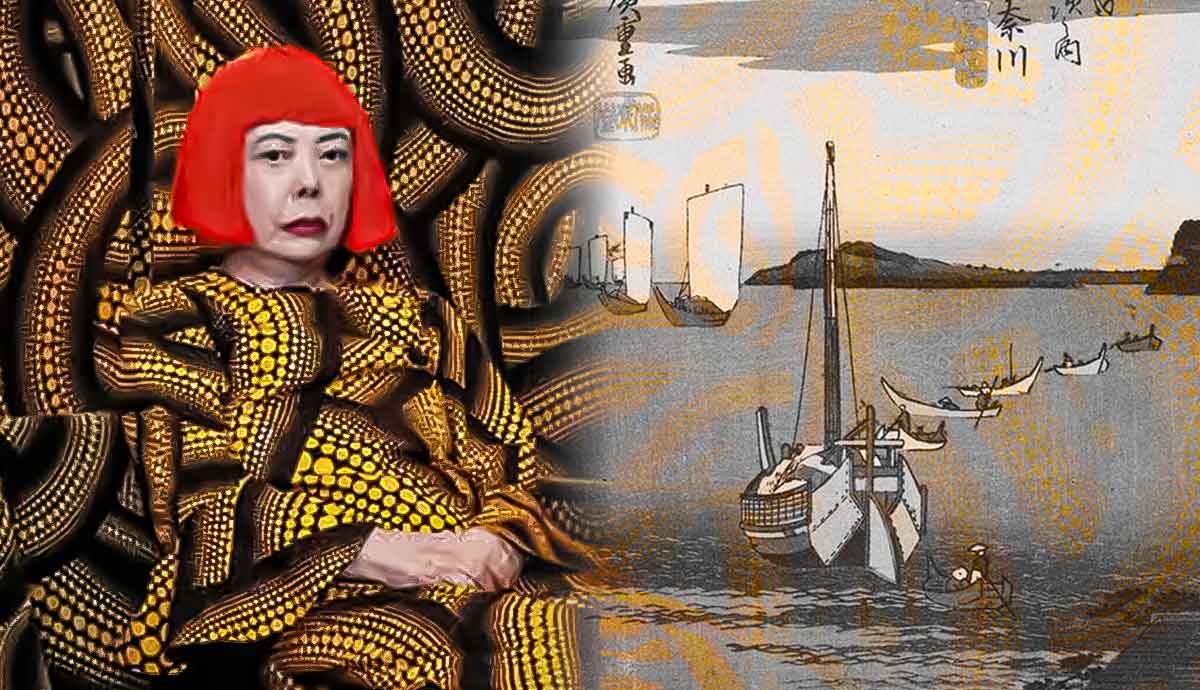
The Ugly Duchess by Quentin Matsys is an influential painting that has many theories surrounding its intention and meaning. The painting is a grotesque—an ancient Greek and Roman art style that was revived during the Renaissance, especially in Italy, as artists began to look back to ancient Rome for inspiration. One of those artists, Leonardo da Vinci, would go on to inspire his friend, Quentin Matsys, with a sketch of a grotesque. The resulting painting would enthrall viewers for hundreds of years.
The Ugly Duchess and the Rebirth of Classical Values

In The Ugly Duchess, originally called The Grotesque Old Woman by Quentin Matsys, the subject is dressed in sumptuous clothing, which directly contrasts her exaggerated features. The individual embroidery stitches are visible on her hood, which is positioned under a long white train of drapery pinned with a golden jeweled brooch. Golden rings adorn her fingers, her raised hand illusionistically extending from the frame into the three-dimensional space. Her breasts are painted to appear almost deflated, sagging out of her low-cut neckline, which was one of the latest trends amongst young women at the time. She is presented in front of a green background as a beautiful young maiden would be presented in her wedding portrait. It was originally paired with another portrait of an old man.

In the Renaissance, classical values began to become more prominent throughout society for the first time in hundreds of years. It became a mark of sophistication to look back on the ancients and incorporate them into your own skills, knowledge, and values, especially in Italy. In art, an example of this can be grotesques. Grotesques date back to ancient Greece and Rome, in which artists would create either 2-dimensional or 3-dimensional images of people with extremely exaggerated features.
The word “grotesque” comes from the Italian grottesca (“of a cave”), and was used to describe the ancient Roman artwork that was found, in which faces were made to look distorted, often frightening or silly. As the return of classical values brought these exaggerated features back into the art sphere, they enthralled some and repulsed others. Leonardo da Vinci became interested in grotesques, and his influence would spread north to Flanders, where his friend, the artist Quentin Matsys, worked.

Quentin Matsys was a Flemish artist of the 15th and early 16th century. He is known as one of the first important artists to have come from the Antwerp School in what is now Belgium. He was originally meant to become a blacksmith in life, but after falling in love with an artist’s daughter, he began to pursue art as a career instead, applying to the city’s painters’ guild in which he would be accepted and excel. Though his work is characteristic of the Northern Renaissance, there is clear inspiration from Italy present in his work, possibly from his friend, da Vinci. Despite Matsys creating the painting, he may not have been the creator of the duchess’s image.
Matsys and Leonardo da Vinci had a close friendship and wrote to each other regularly, exchanging sketches and ideas for their artwork. Some of these sketches that still exist are remarkably similar to The Ugly Duchess. These sketches were passed back and forth between the artists for years before the painting was completed, making it impossible to know exactly who came up with the idea first. The resembling sketch by Leonardo da Vinci is titled Grotesque Head.
It is not difficult to feel empathy for the duchess in the portrait, for her title is cruel, but what is the context behind the artwork’s creation? Who was the duchess? Is she a satirical representation of the grotesque, an ancient form of artwork that was scorned by the counter-reformation when it reappeared? Was she a real woman suffering from a rare disease? Does the painting depict a crossdresser, as cross-dressing was common at carnivals in the 16th century, and Metsys was known to enjoy attending them? Though the truth may never be known for sure, these are three main theories.
1. A Theory of Satire

Grotesques were not the only thing making a comeback from ancient times. Satire was also on the rise, in art, literature, the performing arts, and more. Satire became a way to humorously express qualms about societal issues—or perceived ones. Leonardo da Vinci’s Grotesque Head was one of the many sketches passed between Leonardo da Vinci and Quentin Matsys, and despite who created the first sketch, was clearly an essential source of inspiration for Matsys’s The Ugly Duchess. This would mean that the duchess is likely a representation of the grotesque as satire. What, though, are they satirizing?
The painting is reminiscent of marriage portraits, which were commonly commissioned after weddings to immortalize the union. Naturally, wedding portraits were usually done when a woman was still in her youth. The duchess’s fine clothing and accessories echo those of a young bride following the latest fashions. The satirical message is presented in the form of an old woman wearing the latest trends, presenting herself to her new husband as a young maid would.
It is a scene meant to be laughed at by its contemporaries, a cruel joke at the expense of women attempting to hold onto their youth, and a subtle social warning to women that their youth is highly valued in society, yet can never be returned once lost and therefore it is futile to try. Dr. Britta New, the conservationist and restorer who worked on The Ugly Duchess, believes that the duchess is not a real person, but a satirical character painted by Matsys after he was inspired by da Vinci’s sketches.
2. A Theory of Disease

Though it seems likely that the painting is satire, due to the ancient background of grotesques and satire in art reappearing in the Renaissance, this might not be the case. Was the duchess in the painting a person who lived and existed, or is this simply an imaginary person meant to send a message through her representation as an old woman dressed as a blushing bride? When experts at the National Gallery in London, which houses the painting, took the painting to be analyzed by Dr. Baum from University College London, he declared that the sitter appears to be suffering from Paget’s disease, which is a rare disease that causes growth and malformation of the bones due to problems with metabolism.
If this was the case, she would have been suffering from a very rare form of the disease as well, since it usually affects the lower half of the body, not the upper half like it seems to in the portrait. If she was suffering from this disease, however, it likely would not have shown up until she was past her youth, re-opening the possibility of satirical intentions once again, made even crueler by the possibility of her existence and medical issues. The National Gallery’s website prefers to take a more positive approach to the painting, claiming that a cruel joke is possible when considering intention, but that what one can also see in the painting is a strong woman who has shirked the opinions of society to dress in a way that made her feel confident in the face of a life-altering disease.
3. A Theory of Crossdressing

The theories of satire, Paget’s disease, or both, date back to at least 2008, but a more recent theory from 2023 comes from Dr. Emma Capron, the National Gallery’s Renaissance Paintings Curator, who claims that she believes the painting is not depicting an old woman at all, but an old man crossdressed as a woman during a carnival. She explains that Matsys was fond of attending carnivals and that it was typical to see crossdressers at carnivals in the 16th century. Dr. Capron suggests that the inclusion of breasts could have stemmed from one of Matsys’s fantasies. When asked her opinion on the Paget’s disease theory, she explained that she was wary of doctors giving diagnoses to paintings.
As satirical paintings became favored in the 16th century, and grotesques were rising in popularity with each passing decade, the Catholic Church was in the midst of the Counter Reformation. The Counter Reformation affected the art market severely in Catholic regions. The Church originally believed in religious artwork, to allow the illiterate to know the stories of the Bible, despite their lack of education. In response to Protestantism sweeping across the continent, they aimed to create propaganda for the faith in the form of artwork. This also meant stifling any artwork that went directly against their agenda.
The Catholic Church was openly scornful of grotesques making a comeback in the art field. As Protestants did not believe in the artistic representation of holy figures, they turned to secular art instead, such as grotesques and other satirical art. The Catholic Church was aware that the origins of these artworks came from ancient Rome when the population was Pagan, and therefore they saw it as a societal threat to their belief system and their power across Europe.
The Ugly Duchess Inspiring Literature

The painting’s original title was not The Ugly Duchess. Instead, it was The Grotesque Old Woman, creating a direct link to the grotesques of ancient times that today has been lost as the English understanding of the word, “grotesque,” becomes increasingly warped from its original meaning to simply mean “gross.” The painting has since taken on the new name of The Ugly Duchess. The new name comes from a nickname it was given after the artist Sir John Tenniel was inspired by the painting to create illustrations for Lewis Caroll’s Alice’s Adventures in Wonderland.
The direct inspiration is clear in the illustrations, and the situation serves as an example of how pieces of cultural media can affect each other despite the hundreds of years between their creation. As Alice in Wonderland was influenced by Matsys’s painting, the painting was also influenced by its use in the book’s illustrations by taking on a new name.










